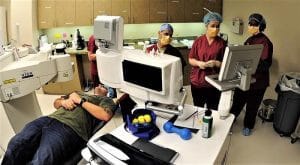If you’ve ever been interested in the world of optical health and care, then you might have found yourself wondering where some of the latest accomplishments in this industry come from. While there are many organizations out there that contribute to the development of eye health and surgery solutions, one of the most innovative groups in America is the National Institutes of Health.
The National Eye Institute was born from a mission to help support and conduct the research that the eye industry needs to overcome common diseases to do with refractive disorders, visual function, and blinding eye conditions. The eye institute also helps with supporting people who suffer from blindness and finding solutions to special eye health problems.
How Does It Change the World?
The National Eye Institute is actually celebrating its fiftieth birthday this year (2018). That means that it has spent fifty years helping to diagnose and treat eye diseases and visual impairment issues. The NEI is also a federal agency of the US government, and it’s recognized as a tax-exempt organization. Those interested in giving something back to the optical world of health can make donations to the NEI without paying tax on their contributions.
Thanks to continued support from the public and the US congress, the eye institute has made some significant advancements in the treatment and prevention of various visual disorders. For instance:
- Age related macular degeneration research has discovered new treatment options for patients with AMD. The NEI found that taking supplements with zinc and antioxidants can reduce the vision loss caused by AMD.
- Research funded by the NEI has found a number of powerful treatments for the condition of diabetic retinopathy – a disease that can blind people with diabetes. Clinical trials have demonstrated that laser surgery on the eye as well as blood sugar control can help to slow vision loss caused by the disease.
- Noninvasive image has been introduced to the world of visual treatment thanks to NEI. Scientists can use this technology to see the tissues deep within the eye and look for issues that might indicate disease and deterioration.
- NEI has helped to support various forms of research into the drugs and treatments that can reduce the pressure on the eye that can lead to a blinding disease caused glaucoma.
- The NEI has supported various research and development projects that have helped to create laser treatments for people with refractive errors. This means that without the eye institute, you wouldn’t have the PRKand LASIK treatments that you have today.
- NEI funded research has also led to a treatment option called cryotherapyfor a disease called retinopathy of prematurity. This disease can have an impact on premature children, and the treatment involves freezing outer parts of the retina to prevent blindness.
- NEI trials have also shown that a common childhood condition called amblyopia can be treated with the use of systems that prevent the use of the stronger eye for a short time using an eye patch or eye drops. This treatment solution strengthens the weaker eye by pushing it into activity.
The History of the National Eye Institute
The national Eye institute was first established in August in 1968, when the president of the time – President Johnson signed a new law. The NIH institute was the first organization created by the government that was fully dedicated to researching and overcoming the visual diseases and disorders that plague mankind. Operations first began in December of the same year, and they have been growing more incredible ever since.
The national Eye Institute was created to help prolong and protect the vision of people all throughout America. Today, the treatment that this organization conducts has led to some of the most incredible sight-saving treatments in the world, capable of improving the quality of life for various people.
The research conducted by the national eye institute has also helped scientist and medical professionals to learn a little more about how our eyes work and how we can protect them in the future. Currently, the Eye Institute offers training awards to scientists from over 250 medical centers and universities, as well as other institutions. At the same time, the NEI supports research into vision through over 1600 research grants.
The Future of the National Eye Institute

Thanks to the national eye institute, we’ve accomplished incredible things in the world of vision. From laser corrective surgery, to bionic eyes, we’ve seen things in the new world of optometry that could only have been dreamed of in the past. Going forward, the National Eye Institute plans to continue their work on various pioneering new advances in the treatment and prevention of vision loss.
For instance, the NEI AGI strategy will be looking into the concept of eye diseases that damage nerve cells within the retina which sends signals for light to the brain. This damage in the retina can cause permanent blindness or vision loss in people of any age. The new AGI strategy is coordinating new approaches to help regenerate the retina and the way that it connects to the brain. One option, for instance, is the use of stem cells, which scientists are working on using to help treat age-related macular degeneration.
On the other hand, the NEI is also looking at options when it comes to things like gene therapy, and the part that genetics and DNA has to play in recovering from eye issues. Researchers in the scientific world today are looking into gene-based treatments that may help people to overcome a range of eye diseases that come from inheritance. Some of the gene related treatments available today have already moved into clinical trials, while other scientists are looking at things like gene repair.
As part of the exploration into gene repair and gene therapy, researchers are also exploring the genetics involved in complex disease. The causes of issues like AMD and glaucoma are still unknown for the most part, and the national eye institute wants to get to the bottom of these problems. Although most cases of age-related macular degeneration and glaucoma aren’t inherited, scientists believe that genetics play a role.























